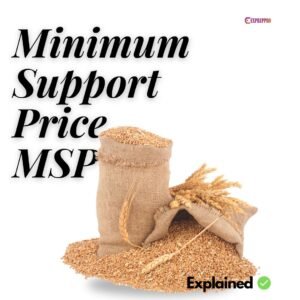
Analysis of 2024 interim budget.
FARMERS WELFARE.
F.M. used the term Annadata for farmers.
There is no hike in PM-KISSAN SAMMAN Yojana from ₹6000 per year. Direct financial assistance is given to 11.8 crore farmers in India.
All agro-climatic zones will get Nano-DAP. A bottle of nano-DAP costs 50% -55% less than an equivalent 50kg bag of conventional DAP. Di-ammonium phosphate is the second most commonly used fertiliser after urea. Its high phosphorus content will stimulate root formation.Nano-DAP contains 8% Nitrogen and 16% Phosphorus by volume. On average, Phosphatic fertilisers account for 18%-20% of the fertiliser subsidy bill, and this decision will have a positive effect on the fertiliser subsidy bill.
Atmanirbhar Oilseeds Abhiyan strategy is to be formulated with a particular focus on promoting edible oil crops and achieving self-sufficiency. If implemented, it will help to reduce import dependency to at least 30%. Annually our country imports about 150 lakh tonnes of edible oil.
The decision has been taken to formulate a comprehensive programme for dairy development.
Five integrated aqua parks are planned to boost the seafood and fisheries sectors.
TOURISM.
The interim budget proposes a ₹176.97 crore outlay for domestic tourism promotion, up from 95 crore in the previous fiscal year.
The total allocation for tourism stands at ₹2344.07 crore. An increase of 38% is recorded.
The allocation for promoting Indian destinations abroad has been drastically reduced from ₹100 crore to ₹3.2 crore. Long-term interest-free loans will be offered to the states to promote tourism development.
The outlay for the integrated development of tourist circuits around specific themes has increased to ₹1750 crores from ₹818 crores. The allocation for the PRASAD scheme has been raised to ₹240 crores.
Allocation of 502 crores for the development of regional connectivity schemes.
HOUSING.
PM-AWAS Yojana (Grameen) is reaching its target of 3 crore houses. An additional two crore more houses will be made in the next five years.
PMAY-Grameen has been allotted ₹54500 crore. During the last fiscal year, it was ₹54487 crore.
HEALTH.
Proposals were devised to encourage Cervical Cancer Vaccination for girls between 9-14 years.
To roll out the U-WIN platform for Mission Indhradhanush immunisation efforts. Initially, it was a proposal for tracking the vaccination status of pregnant women and children.
All ASHA, Anganwadi workers and helpers will get the Ayushman Bharat scheme coverage.
RAILWAY.
Indian railway has proposed an investment of at least ₹1100000 crore across three upcoming freight And cargo corridors.
- The energy, mineral and cement corridor.
- Port connectivity corridor.
- High-traffic density corridor.
The development of 434 more minor projects will lead to an addition of over 40000kms over the next 6 to 8 years.
SUSTAINABLE DEVELOPMENT.
PM Suryodaya Yojana will aid in achieving ‘NET ZERO’ by 2070 and help households save ₹15000 to ₹18000 annually by installing rooftop solar panels. The budget allocated ₹10000 crore rupees to implement this project.
One crore households will get 300 units of free electricity. It will also help enable more E.V. charging points and create entrepreneurship opportunities.
It can save about 2lakh crore for discoms over the next 25 years.
Gujarat has the highest installed capacity under the grid-connected solar rooftop programme. The total installed capacity under the grid-connected solar rooftop programme is 10406MW. In this list, Gujarat tops with 3174MW, then Maharastra with 1852MW, and the third state is Rajasthan with 1067MW.
MGNREGA.
The allocation for MGNREGA is 43% higher than the budget estimate of FY24, and this year’s outlay is 86000 crore.
DEFENCE.
The defence budget saw an outlay of ₹621540.85 crore, which is 4.72% higher than the previous year. Revenue expenditure other than for salary has been fixed at ₹42088 crore.
FUND FOR TECH RESEARCH.
F.M. announced 1 trillion corpus to help finance technology research. A corpus of 1 lakh crore will be established with a fifty-year interest-free loan. This decision will significantly encourage the private sector to scale up research and innovation in the sunrise sectors.
EDUCATION.
The revised estimates for the current fiscal year show a 7% reduction in education allocations. The national education policy seeks to spend 6% of GDP on education, but the budget has yet to reach that allocation level.
PRODUCTION-LINKED INCENTIVE.
The Interim budget has made a token allocation for production-linked incentive schemes for two new sectors.
- Toys
- Leather and footwear
(subject to approval by the union cabinet). The interim budget has fixed disbursements from PLI at ₹6200 crore next fiscal, about 33% higher than this fiscal year. The toys sector got a total outlay of ₹3489 crore.

NOTE-
The current one is an interim budget, so a complete 360-degree comprehensive analysis has some limitations. However, we can still gather valuable insights from the available data.
Based on Interim Budget document,2024.



